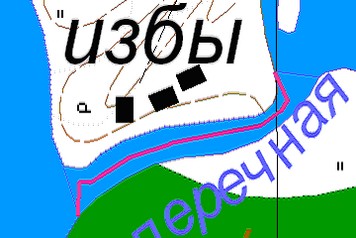Preliminary preparation of source data |


|
|
Necessary condition of automatic processing of the square river is the presence of two or more linear objects (inflow, a source), topologically associated with the river being processed. To obtain the best results, before starting the process of generalization of the square rivers, check the metrics of the objects to be processed in order to satisfy the following rule: the beginning of the metric of the main section of the processed river should correspond to a point of an junction of the main inflow. Usually the point of an junction of the main inflow is located at the greatest distance (along the river bed) from a mouth corresponding to the initial point of the next object along the river current. To ensure the described rule, it is necessary to check the position of the first point in the metric of square object. For this purpose to set a mode of display to the View / Map image / Normal with nodes. In this mode, the first metric point of each map object is marked with a red marker, the first segment of the metric is marked with a red dashed line. At detection of the objects which are not corresponding to the described rule then in the Select Object dialog (Metric bookmark) the specifying the first point of the metrics of the closed contour of the square river is carried out. For a choice of the first point it is necessary: - set the maximum size of dialog the Select Object for displaying a contour of object; - stand onto the desired point of the contour of the object; - in the contextual menu to choose the mode to Set as the first the chosen point of the metric.
If the specified first point does not coincide with a point of the inflow metric it is necessary to coordinate these points in the interactive mode the Map Editor / Topology / Snap vertex. In the figure the case in which it is necessary to carry out specifying the first point is shown.
Specifying the first point of the metrics of square river:
On the first fragment the red arrow shows the location of the first point of the metric of the square river. On the second fragment, the red arrow indicates the new location of the first point. The red dashed line shows the channel of the square river, which corresponds to the metric of the linear river (upon termination of reformation). After the reformation of an area river into a linear one the position of the first point of an area river will correspond to the position of the first point of the linear river, i.e. source of the processed river. And also, for obtaining the best results it is recommended to carry out an insert of an additional (average) point into sections of the adjoint square objects of hydrography when the adjoint section consists of two points.
Insert of additional points into sections of the adjoint square objects (additional points are highlighted by red color):
In order to speed up the process of detecting objects which are not corresponding to described rules, it is recommended to perform a test generalization of hydrography. The analysis of quality of the output map is carried out on the basis of the error log (messages) received upon terminating the process of generalization of hydrography objects, in the dialog the Map Editor / View error. The dialog of protocol includes a list consisting of created linear and square rivers and the deleted square rivers. To view deleted objects, the Hide deleted objects mode should be disabled. When moving through the list, you can analyze the results of the generalization process. Incorrectly processed sections of square rivers usually correspond to the described case. To refuse to perform the test generalization of hydrography, in the Generalization parameters dialog box, activate the last line of the registration list and click the Restore button. Then, by viewing the error log (messages) in the Map Editor / View error dialog, edit the object metric that does not match the described rules. After the editing is finished, repeat the process of the hydrography generalization.
|


